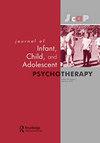Engaging Racial Identification in Children in the Classroom: Commentary on Archangelo and O’Loughlin: Exploring Racial Formation in Children: Thoughts from an Encounter with Black Children in Brazil
Q3 Psychology
Journal of Infant, Child, and Adolescent Psychotherapy
Pub Date : 2021-07-03
DOI:10.1080/15289168.2021.1963114
引用次数: 0
Abstract
With the world in turmoil on so many fronts, psychoanalytic psychology, indeed all of psychology that focuses on the individual mind and individual behavior, faces challenges in maintaining its relevance to the social world. The past 2 years of widespread suffering related to the COVID pandemic, to resurgent political violence, and to racial injustice have upended billions of lives, while exposing how many people have always had to struggle to keep their heads above water. Prominent among the many new challenges facing the mental health fields is how to help children cope with such times of general upheaval. There are aspects of a contemporary psychoanalytic sensibility that can be of use in decoding children’s reactions to their social world, pointing the way toward remedial engagement with ongoing destructive elements. Ferenczi (1933) introduced us to the notion of “identification with the aggressor”; Fanon (1963) put that concept to work in the context of colonial aggression, part of which is the denigration of the subdued population by the colonial occupier. Colonized people, per Fanon, will identify with the aggressor and the denigrated image of themselves propagated by the colonizer. Racial disparities are evident in media coverage, in health care, in the administration of justice, and elsewhere. Children notice these things and adults, especially those who don’t live with protection from these calamities, don’t know how to help them interpret what they see. The effect on children appears in evidence of anti-dark-skinned prejudice in the work of Kenneth Clark and Mamie Clark (1939) and, daily, in classrooms in examples like those cited by Archangelo and O’Loughlin (2021) Their work launches us on a vital consideration of how teachers and others who interact with children can engage with their internalized prejudice and with the socially pervasive projection of “undesirable” characteristics into relatively dark-skinned bodies. I suggest that the preference for white dolls over black dolls noted by Kenneth and Mamie Clark, and by Archangelo and O’Loughlin, is the racially coded tip of the iceberg of children’s reactions to what they see and hear. Furthermore, that the responses they give to researchers’ questions reflect their assumption that grown-ups in authority, especially but not only, white ones, also have a preference for white coloring and expect the same from children. In short, I am suggesting that there is nothing inborn about preference for light-skinned dolls and people; their preferences reflect what they have taken in of nearly ubiquitous prejudice in their social world. I must add, however, that during 3 years during which I worked as a psychologist in the Newark N.J. Head Start program, in which 3and 4-year-old children and families were nearly universally dark skinned, not a single child commented on skin color in my light-skinned presence. I would not doubt that I was discouraging such comments in some way of which I was unaware. One day, however, a little boy sat down next to me and started stroking my arm and I thought “OK here it comes – -“. After a moment, he said “Why do you have so much hair on your arm?”在课堂上参与儿童的种族认同:对Archangelo和O 'Loughlin的评论;探索儿童的种族形成:来自与巴西黑人儿童相遇的思考
由于世界在许多方面都处于动荡之中,精神分析心理学,实际上是所有关注个人思想和个人行为的心理学,在保持其与社会世界的相关性方面面临着挑战。过去两年,与新冠肺炎大流行、政治暴力死灰复生和种族不公正有关的广泛痛苦,颠覆了数十亿人的生活,同时也暴露出有多少人一直不得不努力维持生计。在心理健康领域面临的许多新挑战中,突出的是如何帮助儿童应对这种普遍动荡的时期。在解读儿童对社会世界的反应时,当代精神分析感性的一些方面可以发挥作用,为治疗持续存在的破坏性因素指明道路。Ferenczi(1933)向我们介绍了“侵略者认同”的概念;法农(1963)在殖民侵略的背景下运用了这一概念,其中一部分是殖民占领者对被征服的人口的诋毁。根据法农的说法,被殖民的人民将认同侵略者和殖民者所宣传的被贬低的他们自己的形象。种族差异在媒体报道、医疗保健、司法和其他方面都很明显。孩子们会注意到这些事情,而成年人,尤其是那些没有受到这些灾难保护的人,不知道如何帮助他们理解他们所看到的。在Kenneth Clark和Mamie Clark(1939)的研究中,这种对儿童的影响体现在反黑皮肤偏见的证据中,在Archangelo和O 'Loughlin(2021)所引用的例子中,这种影响每天都出现在课堂上。他们的研究让我们思考,教师和其他与儿童互动的人如何应对他们的内化偏见,以及社会上普遍存在的将“不受欢迎的”特征投射到相对深色皮肤的身体上。我认为Kenneth和Mamie Clark以及Archangelo和O 'Loughlin所提到的对白人玩偶的偏好是儿童对他们所看到和听到的反应的种族标记的冰山一角。此外,他们对研究人员问题的回答反映了他们的假设,即掌权的成年人,尤其是但不仅是白人,也偏爱白色,并期望孩子们也喜欢白色。简而言之,我的意思是,对浅肤色的娃娃和人的偏好并不是天生的;他们的偏好反映了他们所接受的社会中几乎无处不在的偏见。然而,我必须补充一点,在我作为心理学家在新泽西州纽瓦克的“开端”项目中工作的3年里,在这个项目中,3、4岁的孩子和家庭几乎都是深色皮肤,没有一个孩子在我浅色皮肤的面前评论肤色。我毫不怀疑,我在某种程度上阻止了这样的评论,而我自己却没有意识到。然而,有一天,一个小男孩坐在我旁边,开始抚摸我的手臂,我想:“好吧,它来了!”过了一会儿,他说:“你胳膊上为什么有这么多毛?”
本文章由计算机程序翻译,如有差异,请以英文原文为准。
求助全文
约1分钟内获得全文
求助全文
来源期刊

Journal of Infant, Child, and Adolescent Psychotherapy
Psychology-Clinical Psychology
CiteScore
1.70
自引率
0.00%
发文量
37
 求助内容:
求助内容: 应助结果提醒方式:
应助结果提醒方式:


